"Get That Pit Bull Away from Me!": How Data Collection, Visual Identification, and the Media Created a Neighborhood Monster
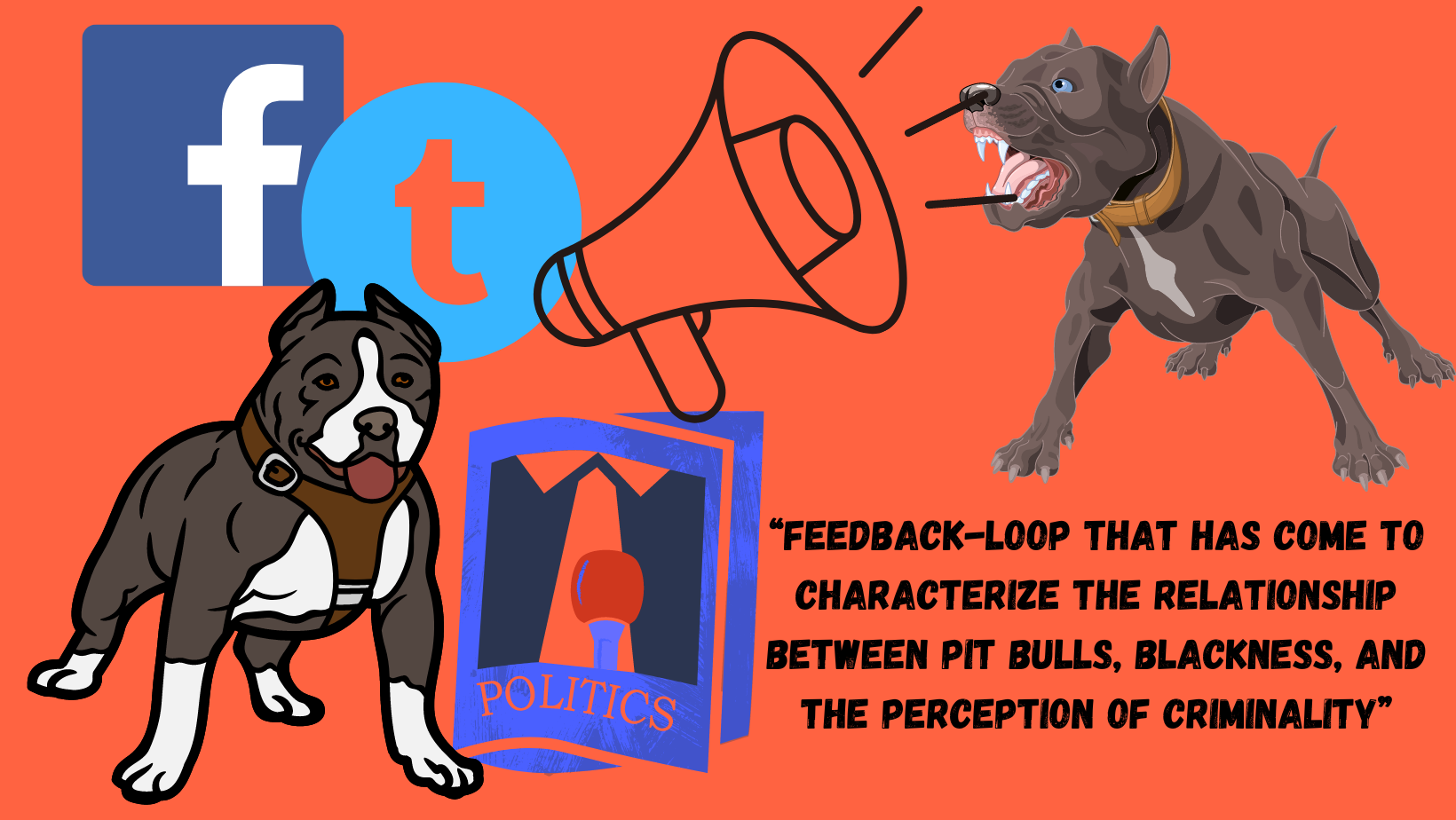
Pit bulls have gained a bad reputation in the news and in our neighborhoods. Breed-specific bans have been implemented in over one-thousand communities across the United States, and these bans most commonly target “pit bulls”(1). Due to the reputation associated with pit bulls, these laws are vigorously supported in many of the communities that implement them. Supporters of these bans will often ask opponents of pit bull-targeted bans, “If pit bulls aren’t as bad as people say they are, then why do I constantly see news about pit bull attacks and not other types of other dog attacks?” In this paper I will provide evidence on how data collection, visual identification, and the media have contributed to the negative stigmas surrounding pit bulls. At the end of this paper, I also address alternate methods to breed-specific bans that can be implemented in our community to increase the safety of our families and our pets.
Data Collection
It is undeniable that the ability to Google almost anything makes our lives much easier. We can type our question into the search engine and within seconds we can have the answer we are looking for. This ease, however, comes with pros and cons. Twenty-something-year-olds will visit a WebMD page and think they know more than their doctor. Stay-at-home moms will spend an afternoon reading about plants online and start calling themselves botanists. The ability to Google anything online has blurred the lines between doing deep scholar-supported research and clicking on the first link at the top of the page that supports a confirmation bias. Pit bull-type dogs fall victim to this type of mentality, and it has contributed to many misconceptions surrounding these dogs.
An important note that is not distinguished in most data: “the term “pit bull” does not denote a specific breed and there is no agreed-upon definition of “pit bull-type dogs” – not in science, the law, kennel clubs, or animal shelters”(2). Rather, the term “pit bull” is a catch-all term that places mixed breed dogs with similar physical characteristics under the umbrella term of “pit bull”1. American pit bull terriers, American Staffordshire terriers, Staffordshire bull terriers, American bullies, and American bulldogs are commonly placed under the umbrella term of “pit bull"(4). When analyzing dog aggression and bite statistics, commonly there is only one category for pit bull, and there is no separation of the five common breeds that fall under this umbrella term. DogsBite.org is a popular website for those gathering data to support pit bull bans. A common chart representing dog bite data is shown below:
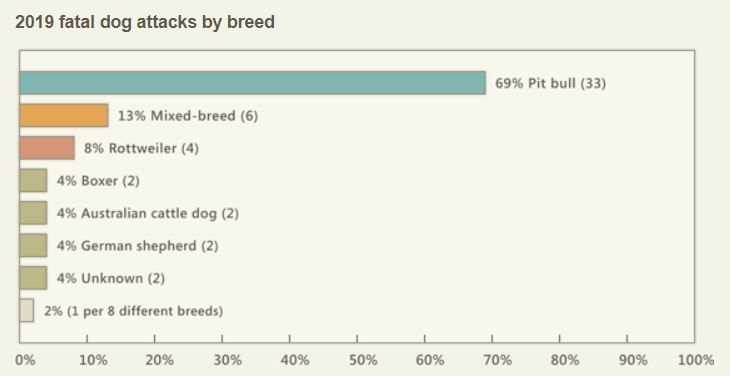
When examining the data presented in this chart, it’s important to ask a few questions regarding the reliability of the information:
1. Who is the author of this data?
2. What are their sources for this information?
3. Why have they only included one category for “pit bull” and not given separate numbers for the different types of dogs in this category?
Sites like these are commonly open-source websites, meaning that anyone can edit and modify the information presented online. Additionally, when examining what the sources are for this particular data, DogsBite.org is open that they retrieve their data from media and news reports. Not scholarly articles or science-backed data, but instead from media reports that are often reported multiple times for the same incident (13). Significantly more media attention is given to attacks involving dogs identified as having the physical characteristics of a pit bull, so relying on media reports as a means to chart dog aggression is increasingly unreliable (1). It is important to examine where we are getting our data from to ensure that we are not unknowingly spreading false information.
Visual Identification
Breed-specific legislation that bans specific types of breeds has been implemented in over one-thousand cities in the United States (1), and most of these breed-specific bans are broadly applied to dogs that are recognizable as a “pit bull” based on their physical appearance (4). Multiple research studies have demonstrated the difficulty of discerning dogs based on appearance alone. Even those very familiar with dog breeds, such as veterinarians and shelter staff, cannot accurately determine the breed of many dogs based solely on their physical characteristics 1. When animals arrive at a shelter, they are often hastily labeled and then marked for adoption. When deciding the breed of dogs, this identification process is often based on appearance; however, due to extensive crossbreeding, approximately 75% of dogs at shelters are incorrectly labeled as “pit bulls”. Today, pit bulls remain one of the most commonly misidentified breeds (10).
A 2009 study by Dr. Voith examined the validity of the labels given through visual identification (2). The study consisted of twenty mixed-breed dogs who had been given a label that stated what their predominant breeds were thought to be. They compared the labels these dogs were given through visual identification against DNA identification. The results showed little agreement between the visually identified breed and the actual breed as given by DNA analysis. Of the sixteen dogs that had been assigned a specific breed at the shelter, the DNA analysis showed that only about 30% of the dogs showed any DNA evidence of the breed they were assigned by visual identification, and over 90% of the dogs did not have their visually identified breeds as the predominant breed in their DNA analysis (2).
The lack of reliability of visual identification has had a detrimental impact on the reputation of pit bull-type dogs. In many cases, pit bull aggression data is derived from news sources that relied on visual identification as the means of identifying the dog in the attack. If professionals are prone to applying incorrect visual labels to dogs, then why would the visual identification given by a neighbor that witnessed the attack be any more reliable? The only effective way to definitely determine a dog’s breed makeup is through genetic testing. Without science-backed evidence to support pit bull aggression data, rather than data that is based on visual identification information, one must question that data that is being presented.
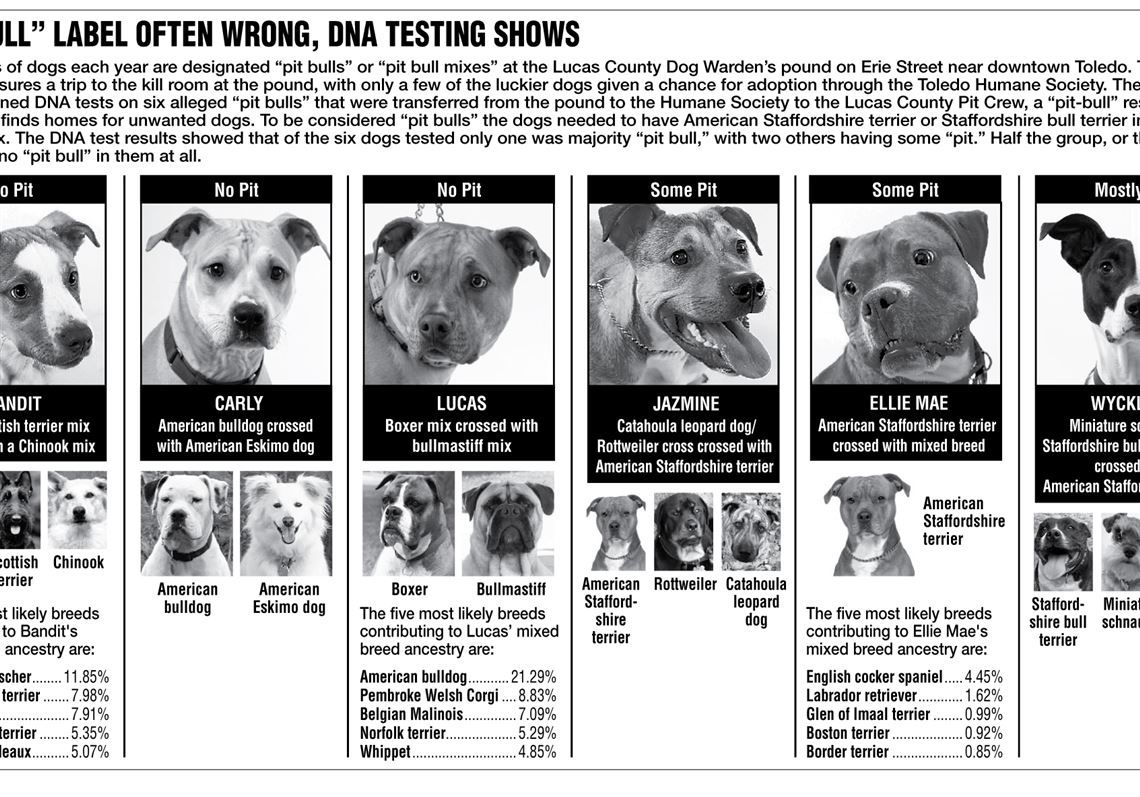
The Media
There is a historical background regarding the pit bull that is not frequently addressed in the twenty-first century. In the early twentieth century, pit bulls were considered “prototypical American pets” (4). They appeared in recruiting posters for World War I and World War II, and were nicknamed “America’s Dog” (4).
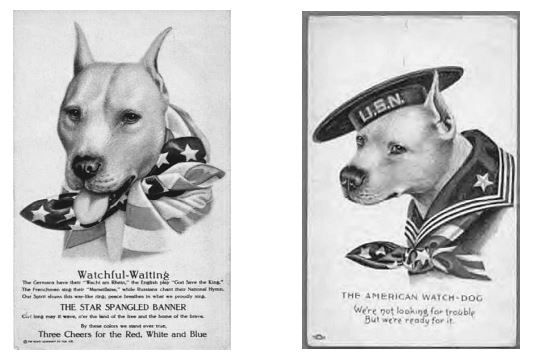
Pit bull-type dogs were also featured in cinema and comic strips involving children, such as The Little Rascals and Buster Brown, due to the pit bull’s affectionate disposition towards children (4).
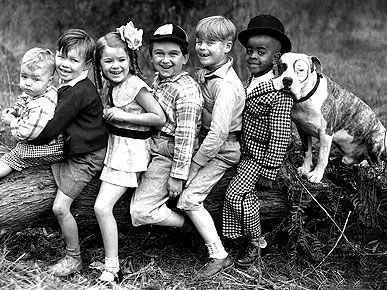
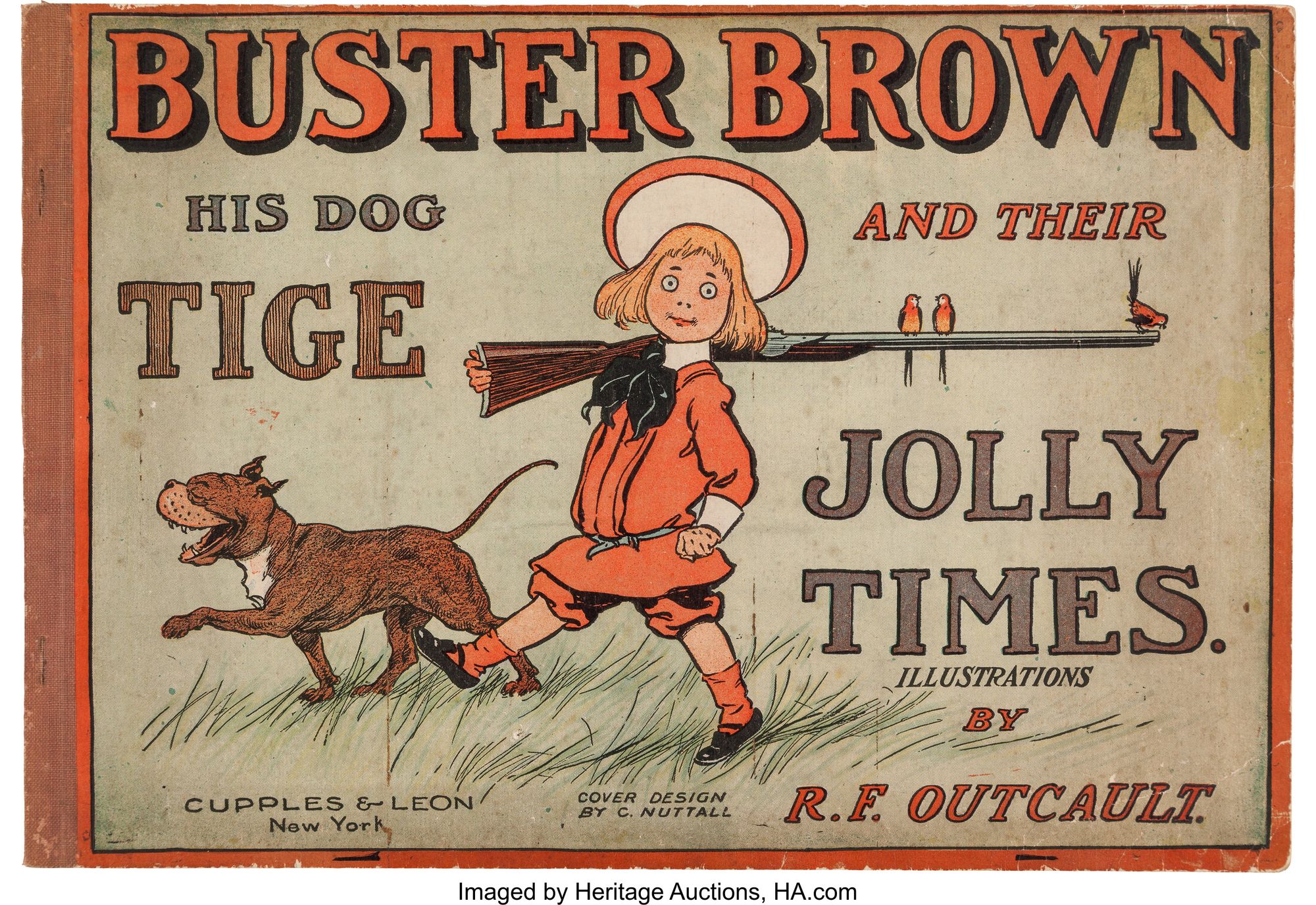
Although once regarded as “America’s Dog” and the children’s best playmate, the pit bull’s reputation began to take on a different tone beginning in the 1980s. A series of reports on rising crime rates gained media attention during this period. Gang violence by urban youth began to be tied to “pit bull” attacks (4). By 1987, law enforcement announced that, “Street dope dealers and street gangs have gone to pit bulls.” The pit bull was swept into the media hysteria involving the War on Drugs, and through this media narrative pit bulls themselves became “carriers of the contagion of criminality” (4). In just over fifty years, the pit bull began to represent a very different America from the one they had portrayed in the early twentieth century (4).
This new and negative perception of pit bulls was also influenced by the pit bulls’ image in the hip-hop scene. Pit bulls appeared in music videos and were featured as cultural symbols of the “Afro-American lifestyles” (4). Especially impacted by the War on Drugs, hip-hop and rap became a strongly racialized genre in the United States, causing the association of pit bulls with this music scene to not be regarded as a positive one (4).
The fear of crime and Black urban youths became associated with pit bulls, creating a “feedback-loop that has come to characterize the relationship between pit bulls, Blackness, and the perception of criminality” (4). These relationships were crystallized with the infamous Michael Vick dog fighting scandal. Michael Vick was an NFL superstar who was arrested for running a dog fighting ring. He was found to have fifty-one abused and mistreated pit bulls on his property (10). The story received significant attention due to Vick’s celebrity status. While this case strengthened the cultural association that had been building since the 1980s between pit bulls and Black culture, it also solidified the “pit bull” as “the dogfighting dog” (4).

The media is a powerful tool; however, unfortunately, more often than not the media is hyper focused on reporting the negative events that happen in our communities rather than the positive ones. No one wants to read a news story about a pit bull going for a walk where nothing eventful happens, but people are more likely to click on a news story that features a pit bull attack. In addition to a focus on the negative events by the media, different news sources often report on the same incident, making it appear as if the event happened more times than it actually did. And due to the bad reputation that surrounds pit bulls, significantly more media attention is given to a dog attack when it features a dog that was identified as a pit bull (1). But even if a dog is identified as a pit bull in an attack and reported to the media as being that breed, visual identification is not a reliable way to definitely label a breed (2). Between the mislabeling of pit bull-type dogs and the media’s intense attention towards attacks concerning these types of dogs, the media continues to falsely advertise the pit bull as being a threat to our safety.
Breed-Specific Legislation: Why It Doesn’t Work and Alternate Methods
Between “pit bulls” being grouped into one generic group rather than being recognized as separate groups, the unreliability of visual identification, and pit bulls gaining a negative association during the War on Drugs, there are countless amounts of pit bull propaganda ready to be used in public discussions regarding the safety of the neighborhood. While much of this information has been misconstrued to fit the pit bull narrative that emerged in the 1980s, there is no doubt that pit bulls have bitten people and other dogs; however, imposing breed-specific legislation that specifically targets pit bull-type dogs is not the answer.
Denver, Colorado has had breed-specific legislation since 1989 that specifically targets pit bull-type dogs. The University of Denver conducted a study over the city’s breed-specific legislation.
Using data from Denver Animal Protection, the agency that enforces the legislation within the city, the study found that the city has spent over $100 million enforcing the ban with little measurable impact on public safety (5). The study also found that there is unequal enforcement of Denver’s breed-specific legislation, with there being unequal enforcement of the pit bull ban in racially diverse and Black communities (5).
The American Veterinary Association also noted that “breed-specific bans are a simplistic answer to a far more complex social problem” (7). Rather than making our communities safer, these bans distract communities from more sensible approaches to dealing with dog aggression. Banning a specific breed can give the community a false sense of security and take away attention from the actual factors that contribute to aggression in dogs. Licensing laws, leash laws, appropriate socialization and training, spaying and neutering regulations, and anti-tethering laws are much more effective approaches to combating aggression in dogs (7).
The CDC also stated that, “many factors beyond breed that may affect a dog’s tendency toward aggression—things such as heredity, sex, early experience, reproductive status, socialization, and training” (8). Reproductive status and socialization are especially important as:
- More than 70% of all dog bite cases involved unneutered male dogs.
- 97% of dogs involved in fatal dog attacks in 2006 were not spayed or neutered.
- A chained or tethered dog is 2.8 times more likely to bite a dog who is not chained or tethered.
Owning a dog, especially a large dog, is not for everyone. Pit bulls, Rottweilers, German Shepherds, and other large dogs who have a reputation for aggressive behavior need to be taken into a home where their needs can be handled. Consistent exercise, socialization, and training are necessary requirements for anyone considering adopting these types of dogs. Dogs such as these do not do well being chained in the yard with no physical or mental stimulation (14).

There are still opponents to this approach, though, who argue, “People who are adopting these large dogs aren’t taking the proper precautions, so banning them is the only answer.” As discussed, breed-specific bans do not work and they take away attention from the main problem. The more attention and money we put towards banning breeds, the less resources we have to implement policies that instill responsible dog ownership habits among those in our community. Some examples of policies that can instill responsible dog ownership and enhance the safety of our communities are:
- Requiring leashing laws in neighborhoods, parks, and other public areas
- Fence height and maintenance requirement if there will be a dog in the backyard
- Laws that prohibit the chaining or tethering of dogs beyond a certain amount of time
- Stricter licensing requirements and regulations for dogs purposed for breeding
- Spaying and neutering regulations for all dogs not purposed for breeding
- Registering dogs who have committed acts of aggression in the past, whether or not the incident was fatal
Years of research and evidence demonstrate that these breed bans do not work, so we need to avoid falling into unproductive patterns and implementing different versions of breed bans. Rather than spreading hate against certain dog breeds in our community, we need to take on a positive community-based approach that facilitates responsible dog ownership among all dog owners. We love our dogs and we want what’s best for them, so let’s implement policies that put responsibility on the owner rather than the all-out ban of a specific breed.
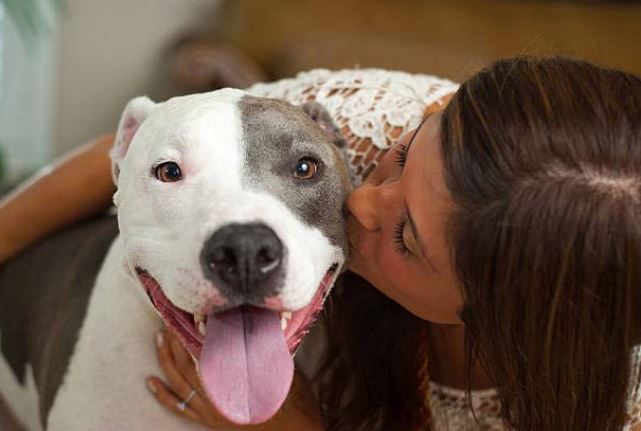
Paper written by Kyleigh Gutierrez. Sources used are listed on the bottom of this page and are numbered accordingly. Suggestions for policies to instill responsible dog ownership habits are my own opinions and I am open to respectful discussion on these points.
Sources
1. https://content.naic.org/cipr-topics/breed-specific-legislation
2. https://nationalcanineresearchcouncil.com/visual-breed-identification/
3. https://network.bestfriends.org/research-data/research/breed-discrimination-insurance#bite
4. https://law.lclark.edu/live/files/32171-25-1-third-articlepdf
5. du.edu/news/new-du-research-measures-impact-denvers-pit-bull-ban
6. https://www.science.org/doi/10.1126/science.abk0639?cookieSet=1
7. https://www.avma.org/resources/pet-owners/why-breed-specific-legislation-not-answer
8. https://www.aspcapro.org/resource/are-breed-specific-laws-effective
9. https://www.dogsbite.org/dog-bite-statistics-fatalities-2019.php
10. https://worldanimalfoundation.org/dogs/pitbull-statistics/
11. https://www.oodlelife.com/what-states-ban-pit-bulls/
12. https://www.researchgate.net/figure/Mean-scores-AE-95-confidence-intervals-of-stranger-owner-and-dog-directed_fig6_233995885
13. https://www.dogsbite.org/dog-bite-statistics-fatality-citations.php
14. https://pethelpful.com/dogs/The-Pit-Bulls-Public-Image-Both-Sides-of-the-Story
